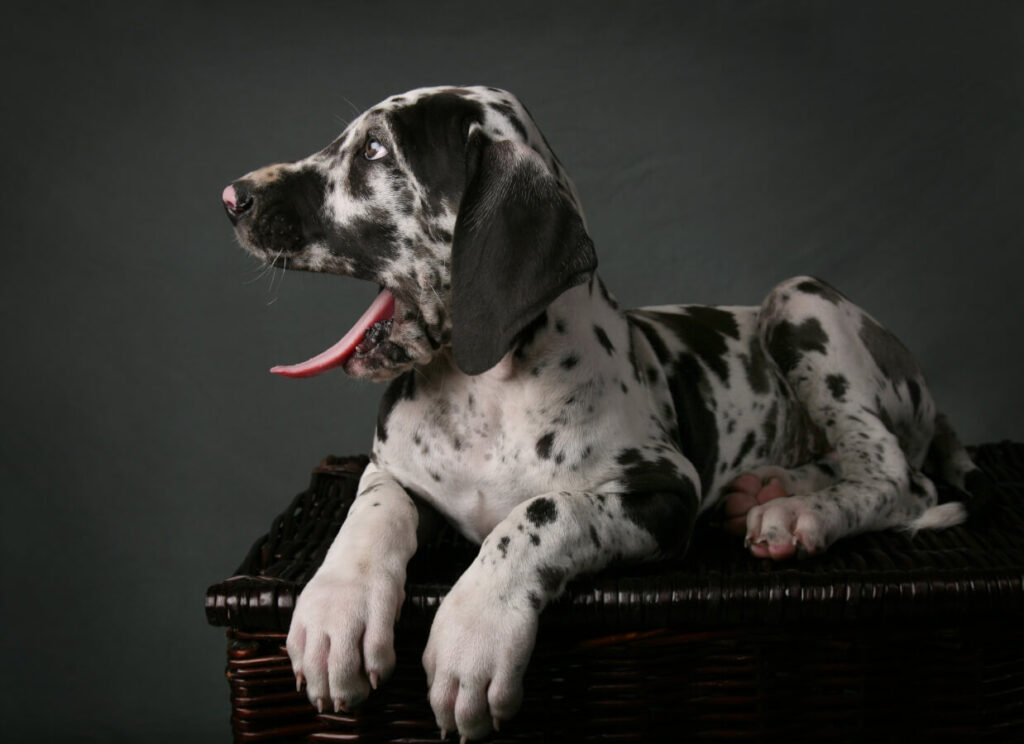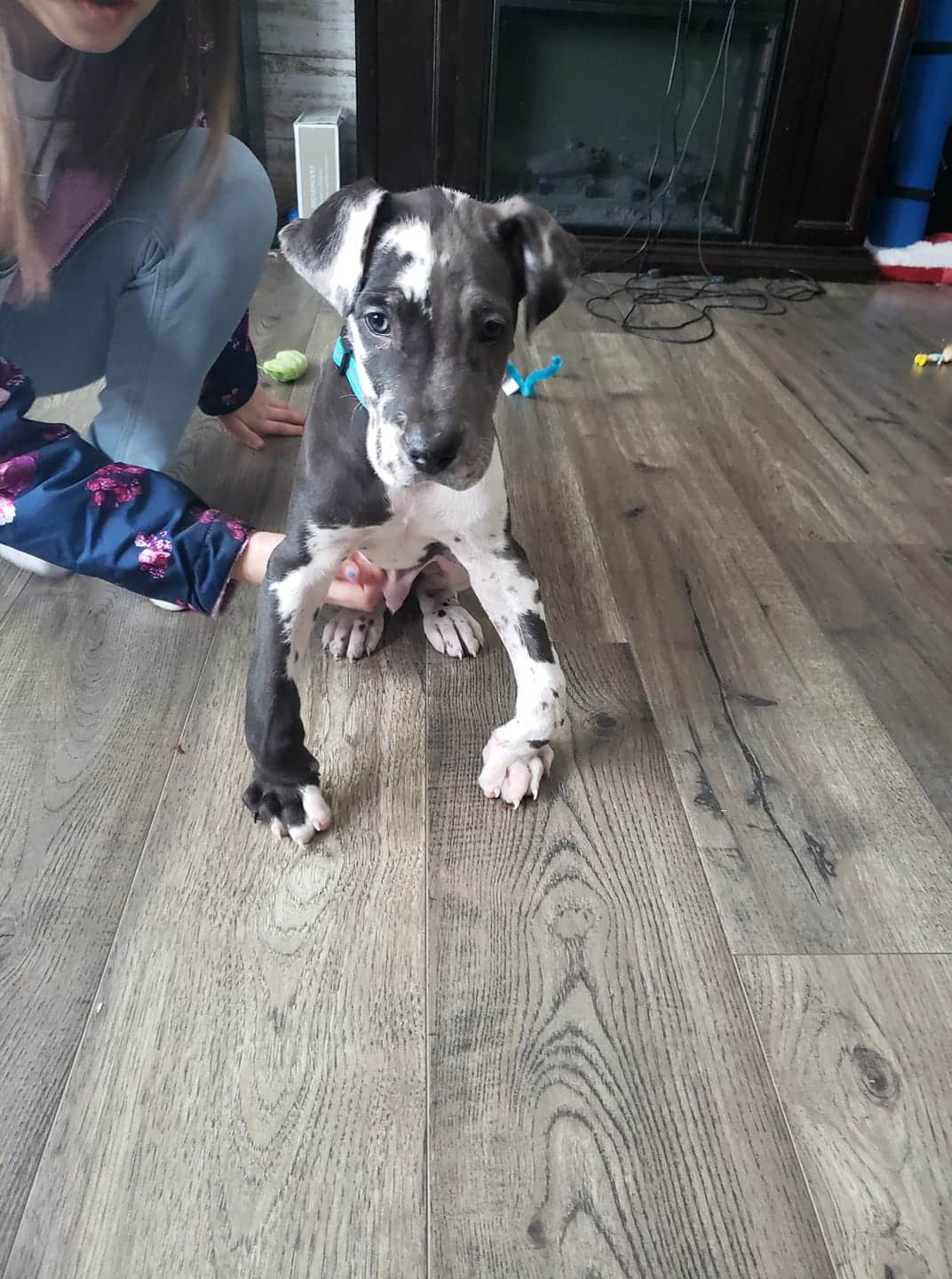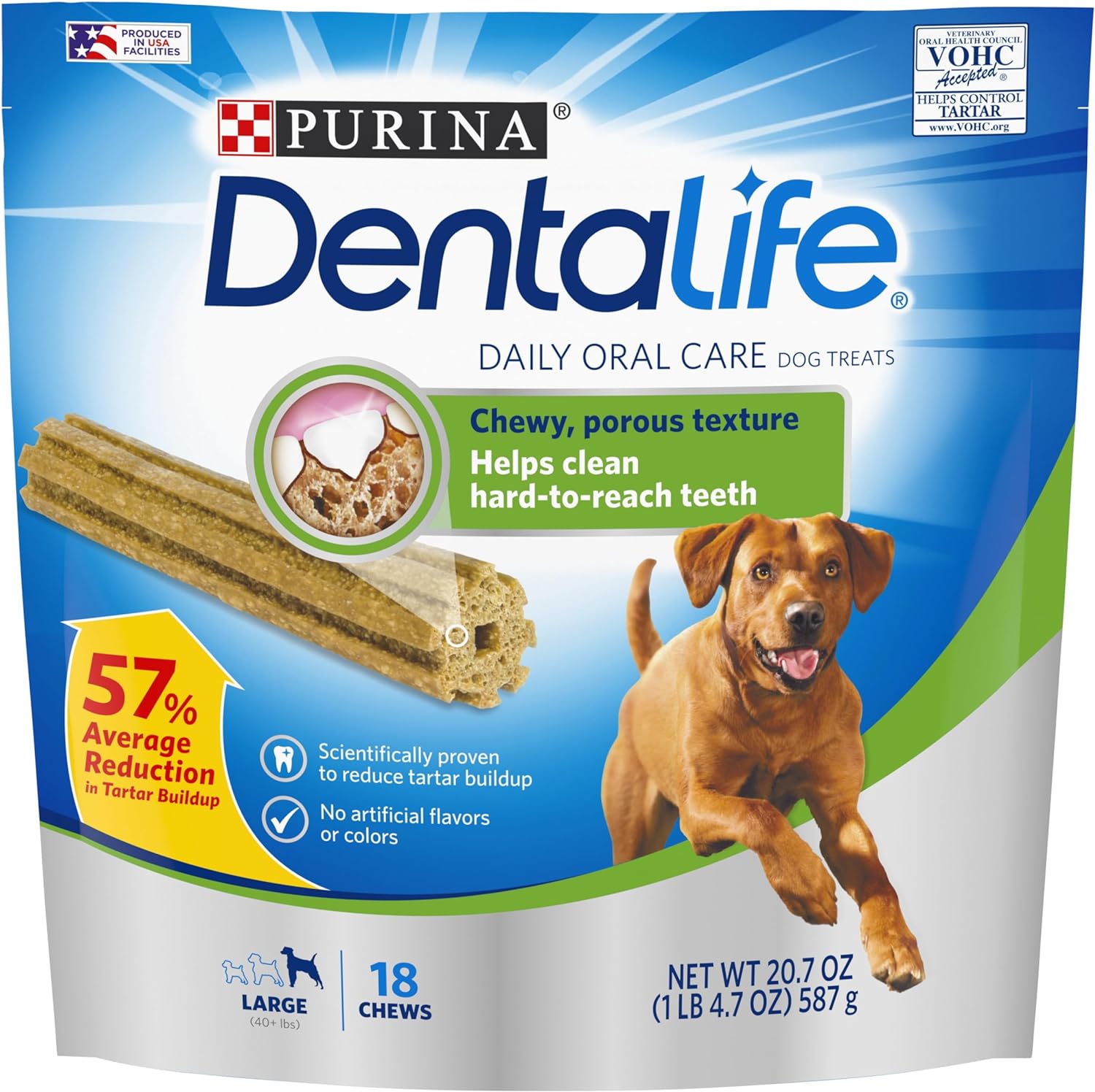If you are concerned because you have a Great Dane puppy with knuckling, crooked paws, bowed-out legs, or bumps on the front legs, you’ve come to the right place. It is important to understand what causes knuckling over, and how to quickly fix knuckling in Great Dane puppies.
Knuckling over, better known as “Carpal Laxity” is one of the challenges that may arise during the explosive puppy growth phase.
As you are now aware, giant breed puppies, known for their rapid growth, can sometimes face orthopedic concerns that affect their front legs. This post is a big one, and in it, we are providing the most up-to-date information based on science & research! Use our table of contents to navigate.
In this post we will discuss:
- How to determine if your Great Dane puppy is knuckling
- What causes knuckling in giant breed puppies
- How to fix knuckling over, flat feet, and carpal laxity in Great Danes
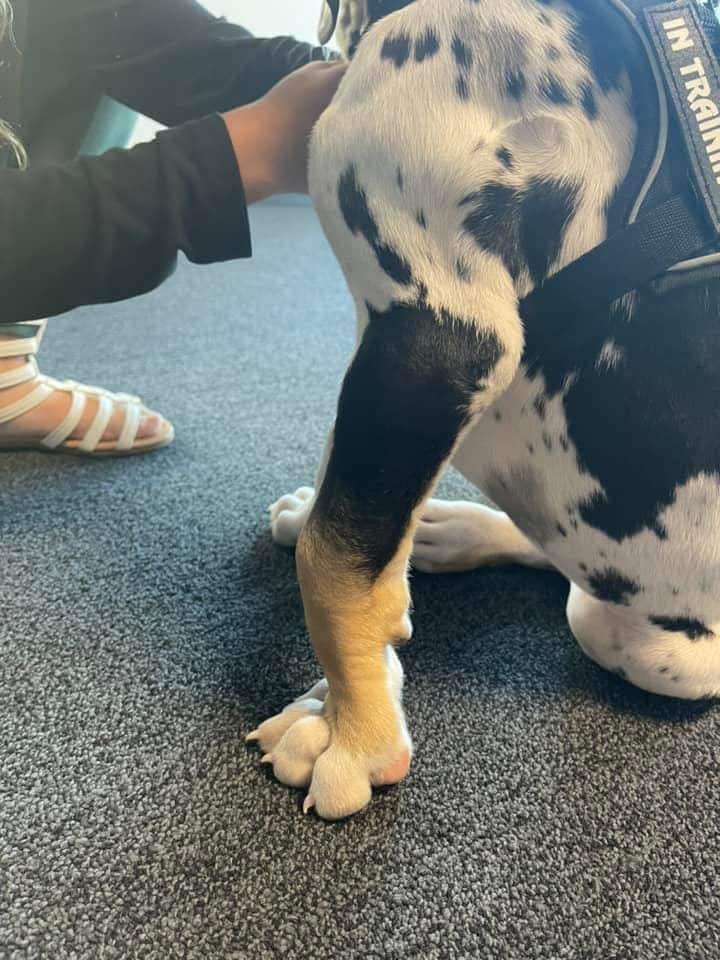
What is Knuckling Over in Puppies?
Knuckling, or Knuckling over is the layman’s term for a large or giant breed puppy when their front limbs collapse. You can see in the image above that the knuckle joint is bowed over the foot.
This condition is a result of fast growth and while it looks alarming, it is one of the least concerning growth disorders that big puppies can face!
For more information on other growth disorders, read HERE.
Is Puppy Knuckling & Carpal Laxity the Same Thing?
The WORD “knuckling” and carpal laxity go hand in hand. However, the word “knuckling” is medically incorrect for this condition.
In other words, the use of the word ‘knuckling’ is actually a misnomer!
When people say ‘knuckling’ in reference to bowed legs on a giant breed puppy, what they really mean is “Carpal Laxity”.
True knuckling is actually a neurological condition, usually associated with more serious disorders in older dogs. To be clear, the use of the word ‘knuckling’ in reference to Great Dane puppy feet is basically slang.
Now that that is out of the way, it’s important to note that I will be using the terms “Carpal Laxity” and “Knuckling” interchangeably in this post.
When you speak to your vet, mention that you have concerns about carpal laxity. This will make much more sense to them, and their diagnosis will make much more sense to you, too!
Is Knuckling Over in Great Danes Serious?
Knuckling over is one of the most common growth complications in Great Danes and other giant breed puppies.
With carpal laxity, the dogs weight becomes too much for the quickly developing bone and cartilage, and the legs ‘buckle’ or go flat in response to the stress.
Some puppies have a mild case of knuckling over, others have a more severe case. Either way, this is a notable (and reversible) condition that requires treatment.
It often pops up with very little warning, and puppies can be normal and then wake up from a nap buckling over. Other puppies show early signs, such as having shaky legs and flat feet.
While the exact cause of knuckling is unknown, it is believed to be related to dysfunctional (too fast) growth, often brought on by improper nutrition. Excessive or improper exercise and slippery or hard surfaces can cause further damage to the lax joints.
It is a condition that requires swift action and treatment, however, it is NOT a serious condition requiring life-saving measures. Don’t stress! With the right treatment, this problem resolves quickly.
This photo above is of an 8-week-old Great Dane puppy who was diagnosed with HOD and knuckling. This is a severe case. Knuckling can look more mild or more severe than this.
Normal Great Dane Puppy Growth vs. Knuckling
Many people mistake normal, knobby growth plates, flat feet, or angular limb deformities with knuckling!
Healthy Great Dane puppies will often have large, knobby growth plates on their front paws. These growth plates may swell a little bit before a growth spurt; this is normal!
However, excessive swelling is indicative of problems such as HOD and PANO which are much more serious than carpal laxity. Always monitor the condition of your puppy’s growth plates and report to your veterinarian; if there seems to be pain, limping, and/or a lot of swelling.
What are the Signs & Symptoms of Puppy Knuckling?
This photo above is a fairly severe case: notice the bowed appearance and toes.
It’s important to understand the warning signs that may indicate early or developing bone growth problems in your puppy, and see a giant-breed-knowledgeable veterinarian ASAP. Left untreated, puppy knuckling can lead to permanent damage and deformity.
Symptoms of puppy knuckling over and carpal laxity include:
- Weak limbs that ‘shake’ on soft surfaces
- Flat toes/splayed feet
- Ankles that rest over the top of the foot
- Bowing out
- Flat feet (another form of carpal laxity)
- Crooked front limbs or ‘ballet feet’ (which may also indicate growth plate damage and angular limb deformity, more serious than knuckling)
We’re going to dig more into how diet affects bone growth in large and giant breed puppies below, but before we get there, check your food! If the calcium level is above 1.2% it should NOT be fed.
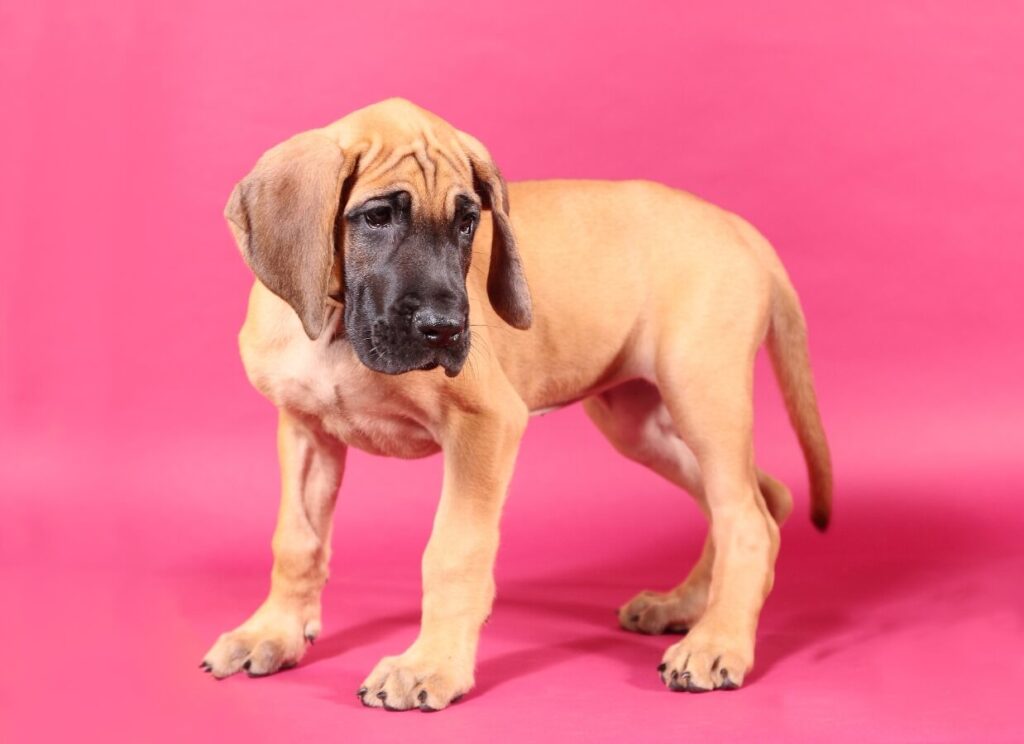
How to Quickly Fix Puppy Knuckling in Great Danes
I’m going to deep dive into the nutritional and environmental issues related to knuckling below, but if you are reading this article you may be looking for a quick fix.
Here is the long and the short of how to QUICKLY fix puppy knuckling:
- Immediately switch, cold turkey, to an appropriate diet (listed below)
- Do not free feed. Reduce and monitor food intake
- Eliminate all treats, toppers, fresh or canned foods, and supplements being offered
- Trim your puppy’s nails (this should be done weekly for life)
- Encourage lots of free play on soft, varied terrain such as grass, sand, and gravel
- Do NOT use a harness, which can restrict natural movement
- Put runners and rugs down in your home
- Avoid slick or hard surfaces and jumping
- Utilize orthopedic bedding
- See your veterinarian for further instruction and monitoring
Here is our heavily researched list of the best foods for Great Dane puppies, especially if they are suffering from any kind of growth or orthopedic disorder:
- Purina Pro Plan Large Breed Puppy – any flavor!
- Purina Pro Plan Sensitive Skin & Stomach Large Breed puppy – TOP PICK, salmon-based
- Eukanuba Large Breed Puppy (Great for active and sporting dogs)
- Purina One Large Breed Puppy (Excellent budget option)
- Hill’s Science Diet Puppy Large Breed
- Royal Canin Giant Puppy Dry Dog food (to age 12 months) – TOP PICK, PREMIUM OPTION
- Royal Canin Giant Junior Dry Dog food (8-24 months)
- Purina Large Breed Puppy Chow
Check out THE GIANT DOG FOOD PROJECT to compare brands and values.
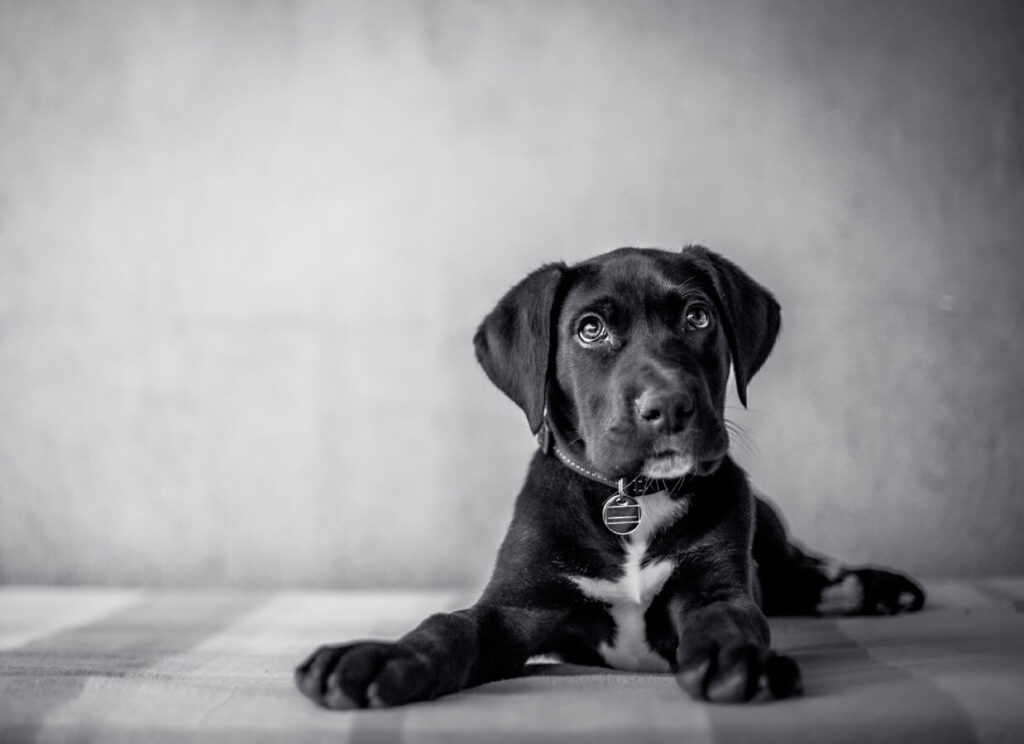
What Causes Knuckling in Giant Breed Dogs?
While the exact mechanism behind the cause of knuckling still needs more research, there are strong correlations to diet and exercise practices. If you have a puppy that is knuckling over, you MUST immediately address the diet.
A proper diet for a giant breed puppy should be like this:
- Formulated by a company with a qualified nutritionist on staff (search your brand here to confirm)
- Large or Giant Breed Puppy OR All Life Stages Formula, NEVER adult-only foods
- AAFCO Large Breed Growth Statement – this is a MUST-have
- 1.2% or less calcium, no exceptions
- 3.5g of calcium or less per 1000kCal
We’ve partnered with the Giant Dog Food Project to develop a search tool that allows pet owners to sort through nearly 700 brands and formulas, and find the ones that match those values. Visit the Giant Dog Food Project Pet Food Search Tool HERE.
Feeding an unbalanced diet can cause knuckling over
Feeding an unbalanced, nutrient-dense fussy diet is thought to be the leading cause of knuckling. Too much calcium and feeding too much food or too many toppers, treats, and supplements cause the puppy to grow unevenly.
Here is a list of things that cause a diet to be unbalanced:
- Poorly formulated kibble (see our recommendations)
- Regular puppy foods that were not designed for large+ breed growth
- Excess calcium intake (which causes lasting damage)
- Overfeeding (leads to overgrowth/fast growth)
- Adding supplements such as calcium or multivitamins
- Adding too many unbalanced toppers such as yogurt, cottage cheese, eggs, and meat
- Offering too many treats and training treats
- Feeding a food that was not formulated for large or giant breed dogs (the ratios are different)
- Mixing two or more types of kibble
- Home-cooked or homemade raw diets (which are rarely formulated correctly)
- Switching diets, especially when doing so often
- Feeding a kibble that is not formulated by a veterinary nutritionist or Ph.D. in Animal Nutrition
Do any of the things on the list above apply to you? We will outline them in detail below.
Feeding the wrong kibble
We believe in science.
Science tells us that the only appropriate kibble for a Great Dane puppy is a LARGE or GIANT breed puppy or “All Life Stages” formula from a brand that meets veterinary guidelines for ethics, sourcing, testing, research and responsibility.
You may have heard that Great Dane puppies should “only have adult food”. This information is outdated in 2022 and may actually be dangerous. We’re digging more into the science of this below!
Choosing an appropriate food for your Great Dane puppy means that it should be:
- Ideally be formulated by an on-staff, full-time, board-certified Veterinary Nutritionist
- A large or giant breed puppy or “all life stages” formulation that was created to support slow, even growth of large and giant breed puppies
- Be rigorously tested, researched and subjected to feeding trials
- Come from an established brand with lots of peer-reviewed research behind it
- Meet nutritional guidelines through feed trials and testing, not just be ‘formulated to meet minimums’ on paper
- Less than 3.5g of calcium per 1000kCal
- 1.2% or less calcium
- Calcium to Phosphorus ratio of as close to 1 : 1 as possible
- AAFCO’s statement that the food was formulated for the growth of (70+lbs) large breed dogs <—important, although not, AAFCO sets minimums. A food can ‘meet the minimum’ and still not be the healthiest choice.
The following brands and formulations are the only ones that meet the requirements listed above. We do not recommend feeding any other food brands to Great Dane puppies, though many people recommend other foods.
- Purina Pro Plan Large Breed Puppy – any flavor!
- Purina Pro Plan Sensitive Skin & Stomach Large Breed puppy – TOP PICK, salmon-based
- Eukanuba Large Breed Puppy (Great for active and sporting dogs)
- Purina One Large Breed Puppy (Excellent budget option)
- Hill’s Science Diet Puppy Large Breed
- Royal Canin Giant Puppy Dry Dog food (to age 12 months) – TOP PICK, PREMIUM OPTION
- Royal Canin Giant Junior Dry Dog food (8-24 months)
- Purina Large Breed Puppy Chow
Check out THE GIANT DOG FOOD PROJECT to compare brands and values.
What are WSAVA Guidelines, and do they matter?
All About Great Dane Puppy Foods
Is Life’s Abundance a Good Dog Food?
Royal Canin Giant Breed Dog Food Review
Switching foods often
Many pet parents will switch their puppy’s food often in an attempt to resolve chronic loose stools, itching, or ‘pickiness’.
All this does is create a puppy who will refuse to eat until toppers or a different food is offered. Picky dogs are created by, you guessed it, US!
This practice also contributes to poor overall gut health, itching, and loose poop.
People mistake these health issues with ‘allergies’ when really, their pup just needs the right amount of correctly balanced food and some time for their gut to adjust.
Choose a proper science-backed food, measure it with a scale, don’t overfeed, and stick with it.
We also recommend probiotics such as Fortiflora.
Home Cooked Diets & Puppy Growth
No matter how ‘healthy’ it may seem to offer ground meat, rice, and veggies in lieu of kibble, home-cooked dog food is rarely balanced correctly. Imagine if you ate that kind of diet every day for breakfast, lunch, and dinner. It wouldn’t take long before you started to suffer from malnutrition!
Dogs need correctly balanced meat, bone, and organs in their diet in addition the the right ratios of protein, carbs, fiber, amino acids, nutrients, and minerals.
The website www.balanceit.com allows you to plug in your home-cooked food recipe and see what it’s deficient in. Even recipes made by “canine nutritionists” and celebrity veterinarians are often wildly incorrect.
Homemade diets should only be made under the guidance of a board-certified veterinary nutritionist and NEVER for growing giant breed dogs.
Overfeeding Great Dane Puppies is Bad for Growth
Feeding too much food to a puppy can cause uneven, fast growth, loose stools, and knuckling.
Your puppy does need to eat a LOT of food. But too much is a problem.
Puppies that are offered poorly balanced puppy or adult foods, who then overeat to try and get the nutrition they need, can suffer from chronic loose stools, knuckling, HOD, growing pains, and permanent joint deformities.
Great Dane puppies that are offered ‘adult only’ food in particular may need to eat much more than necessary.
Adult food doesn’t provide them with enough nutrition for their energy levels and muscle development. This is one reason why we see so many teenage Danes with ongoing loose stools that look like walking skeletons with no muscle: they are literally starved for nutrients and will over-eat to try and compensate.
We no longer recommend choosing adult formulas. All Life Stages Large and Giant Breed Formulas are ok.
A science-backed large or giant breed puppy food from Purina, Royal Canin, Hill’s, Eukanuba, or Iam’s are excellent choices.
Use a scale to measure your dog’s food once they are 3+ months of age. Don’t bribe your puppy to eat.
If they are full, they are full.
Puppy kibbles have more nutrition in the form of calories, fat, and protein. This can make it easy to overfeed, especially if you are used to seeing your Dane pups have to gorge themselves on adult formulas.
Watch your puppy’s body condition and adjust accordingly.
Poor nail maintenance and slick floors
Great Dane puppy nails should be trimmed weekly. Do not ever let them get so long that they touch, scrape or click on the ground.
Hard, slick surfaces contribute to early joint damage.
Encourage your puppy to play freely on soft, varied terrain in lieu of walks on hard pavement. Use runners and throw rugs to eliminate slipping and sliding in your home.
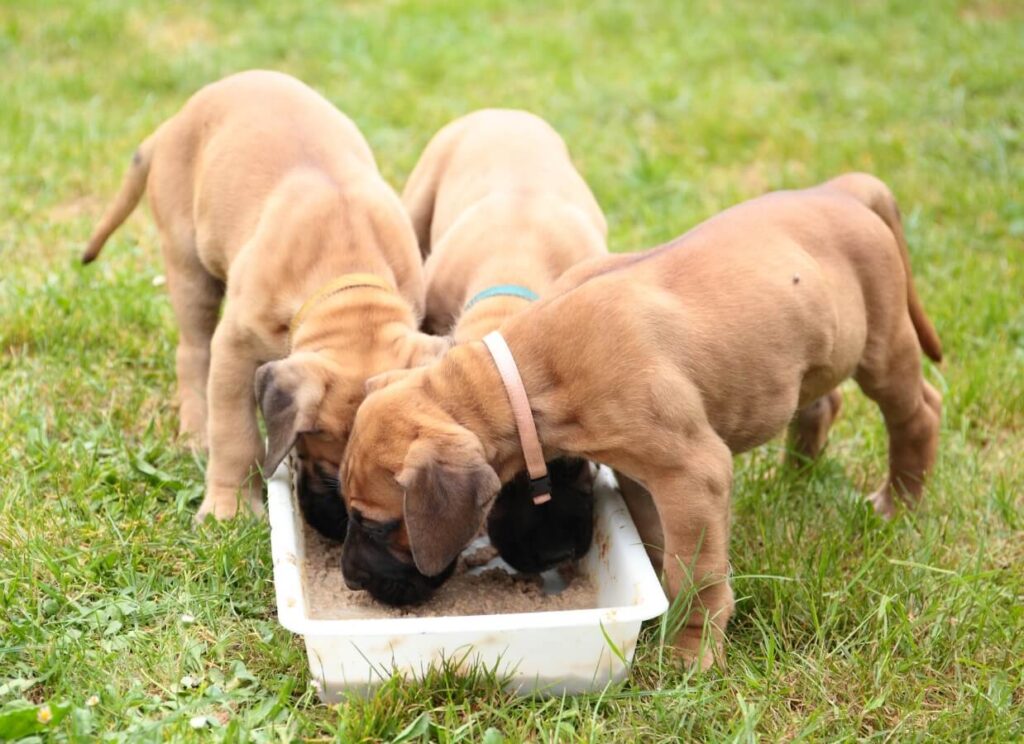
Nutrition & Knuckling in Giant Breeds
It is believed that nutrition is a key factor in bone and growth disorders in giant breed dogs. Current research shows that excess calcium is among the most damaging nutritional problems. Because giant breed puppies utilize every bit of calcium offered to them in their diet (they are unable to get rid of it), their bones take all of it in. That would seem like a good thing, except it’s not!
Excessive calcium is linked to a whole slew of bone growth issues including osteochondrosis, hip and elbow dysplasia, angular limb deformities, retained cartilage cores, and more. Some researchers understandably also speculate that these damaged bones are more susceptible to developing things such as Osteosarcoma (bone cancer) and Wobbler disease later in life.
It is extremely important to find and stick to an appropriate balanced diet for your puppy! Unfortunately, the giant breed community still promotes many myths. These myths are NOT rooted in current research and science.
Common Great Dane puppy food myths include:
- “Great Dane puppies should never have puppy food”
- “Purina, Royal Canin, and Hill’s Dog foods are trash”
- “Protein levels MUST be below 24%!”
- “Fresh roasted deboned meat, fruits, and veggies are healthy and more nutritious for dogs than meat meals made of muscle, bone, organ, and cartilage”
We recommend:
Protein – ignore this number if you are choosing a professionally balanced food recommended on this page. This is a myth that was disproven by peer-reviewed research. The protein level does not matter. The bioavailability of amino acids, as well as calcium and phosphorus levels, DO matter.
Fat – ignore this number as well, for the same reason as above
Calcium 1.2% or lower (1.3 – 1.4 can also be okay if you do not add any toppers or supplements). Overall calcium intake should never exceed 3.5g per 1000kCal.
Phosphorus is close behind calcium.
The following brands are correctly formulated and tested for the growth of our gentle giants.
There are 300-400 new boutique food brands offered each year in the U.S. When you choose science instead of fancy bags and marketing, it’s easy to narrow the options down.
- Purina Pro Plan Large Breed Puppy – any flavor!
- Purina Pro Plan Sensitive Skin & Stomach Large Breed puppy – TOP PICK, salmon-based
- Eukanuba Large Breed Puppy (Great for active and sporting dogs)
- Purina One Large Breed Puppy (Excellent budget option)
- Hill’s Science Diet Puppy Large Breed
- Royal Canin Giant Puppy Dry Dog food (to age 12 months) – TOP PICK, PREMIUM OPTION
- Royal Canin Giant Junior Dry Dog food (8-24 months)
- Purina Large Breed Puppy Chow
Check out THE GIANT DOG FOOD PROJECT to compare brands and values.
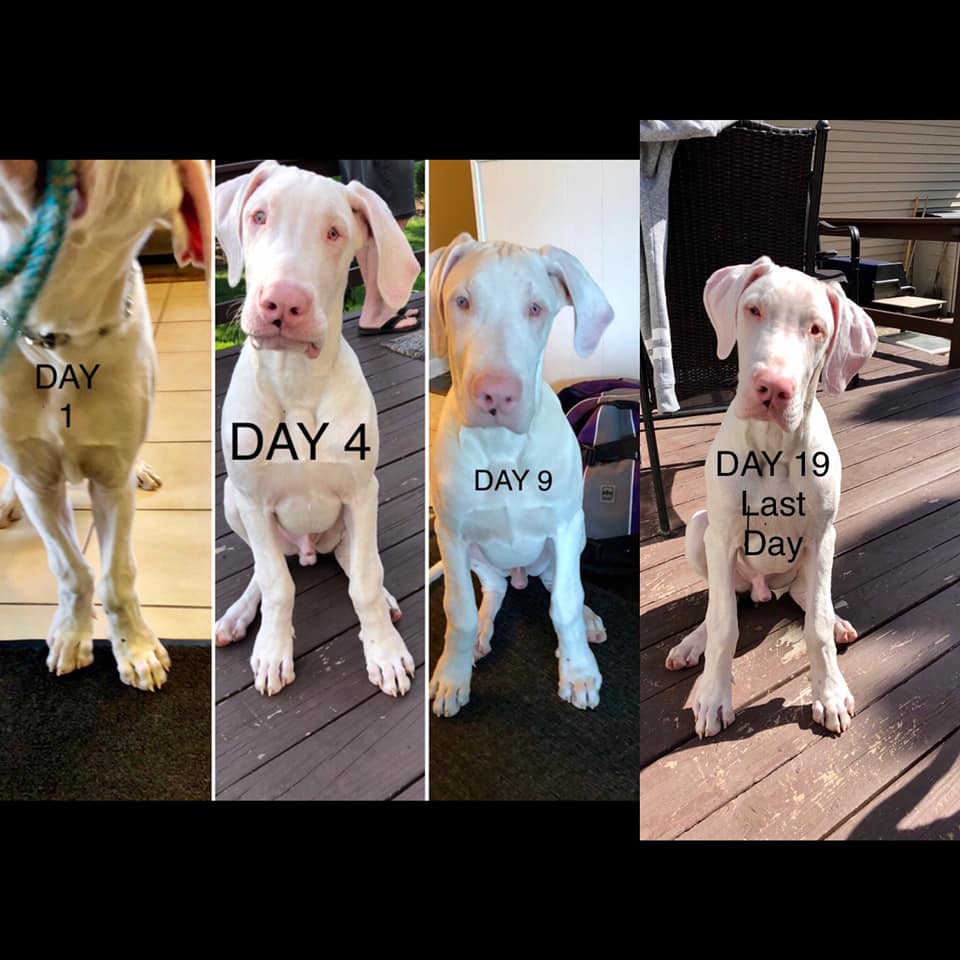
Puppy Food Dealbreakers
Here is a list of ‘Great Dane food deal breakers’! Never feed foods to Great Dane puppies that have a dealbreaker:
- Grain-free kibbles, which can lead to a deadly form of heart disease
- Boutique diets and marketing brands that don’t staff a Veterinary Nutritionist, don’t fully test their foods, and don’t participate in research.
- Foods that don’t meet basic WSAVA Guidelines for ethics and responsibility (see above)
- Vegan, vegetarian, low-meat, or cricket-based dog foods
- Dog foods that utilize a lot of ingredient splitting to trick you
- Foods with fresh ‘deboned meat’ paired with peas, potatoes, fruit and veggies. These foods sound nice but in reality are likely to be heavy in starch and low in meat.
- MLM Marketing Scheme breeder kickback brands (Life’s Abundance, TLC, Paw Tree, NuVet)
Choosing the correct food for your Great Dane puppy is extremely important!
Chat with your breeder and a giant-breed knowledgeable veterinarian for more advice.
Vitamin C for Treating Puppy Knuckling
Many people swear by Vitamin C to aid in the treatment of knuckling in Great Danes. Vitamin C is a known antioxidant that is important in bone formation. However, some researchers say that adding too much to the diet can have the opposite effect.
How to Fix Knuckling in Great Dane Puppies
In addition to addressing the nutritional aspect of knuckling (we recommend switching food immediately with a short transition period), there are other things you can do!
- Change the diet ASAP. This is the MOST important step you can take. Stick with what you choose.
- Add Vitamin C.
- Keep the nails trimmed. They should be trimmed every 5-10 days. Now is the time to start working with a Dremel as well! For tips, look here: https://www.hellodanes.com/how-to-trim-great-dane-puppy-nails/
- Put runners down, everywhere. Your puppy should not be jumping, sliding, running or walking anywhere with a slick surface, especially while treating knuckling.
- Do not allow your puppy to jump up or to launch themselves off of furniture. Use ramps, training, crates, and gates to prevent this behavior.
- Avoid hard pavement and leashed walks, which are hard on joints and don’t allow the puppy to move naturally.
- Don’t run or bike jor with your Dane puppy until they are age 2+, have good hips and feet and are well conditioned to exercise.
- Avoid training methods that use physical force and pressure for down/sit, alpha rolls/pinning, extended down-stay or long ‘pack/structure walks’. None of that is healthy, natural or necessary, especially for giant breed puppies.
- Limit crate time, which can lead to weakness and poor orthopedic development.
- Unless your veterinarian prescribes rest, allow your puppy to freely walk, move, run and explore varied terrain every single day. Grass, sand, gravel, hills, and dirt are great examples. As a bonus, this is great for socialization! Use a long leash or a fenced yard.
- Work with a certified Canine physical therapist to strengthen the feet, toes, ankles, shoulders and core.
- Choose orthopedic beds, like the BIG BARKER (our personal favorite).
- TALK TO YOUR BREEDER! They can be the best resource, especially if you’ve done your research and chosen an ethical breeder that supports your puppy for life.
We always believe that you should also work with a giant-breed experienced veterinarian!
Some bone growth issues are much more serious than knuckling (angular limb deformity, HOD, and Wobblers for example) and it’s important to rule them out.
Have more questions about knuckling or want to share your experience? Leave a comment below!

